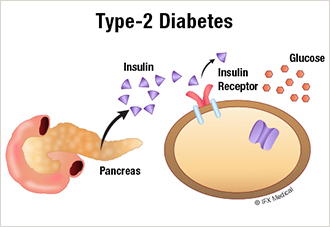Obesity and Type-2 Diabetes
Type-2 diabetes is a chronic condition that changes the way your body uses glucose, or sugar. This form of diabetes is also known as adult-onset or non-insulin dependent diabetes. It is most common among overweight adults, but due to the rising rates of obesity has become common among adolescents in recent years, as well.
Common symptoms of type-2 diabetes are:
- Dehydration and excessive thirst
- Blurry vision
- Dry skin
- Fatigue
- Increased urination
- Confusion
It is not uncommon for pre-diabetes and the early stages of type-2 diabetes to have little or no symptoms. Diabetes is diagnosed through blood tests and regular visits with your physician.
What Causes Type-2 Diabetes?
Insulin produced by pancreas opens channels in cells to allow entry of glucose

Insulin is unable to open channels into cells resulting in increasing levels of blood glucose
Type-2 diabetes is caused by changes to the ways the body produces or uses insulin, a pancreatic hormone responsible for managing glucose levels in the bloodstream.
In a healthy individual, the pancreas secretes insulin into the bloodstream where it then transfers glucose into your cells. Once in your cells, glucose is then converted to fuel. This reduces the level of sugar in your bloodstream. The less sugar in your blood, the less insulin your pancreas has to produce.
High levels of fat and excess weight make it difficult for the body to correctly use insulin, which is why obesity is a leading risk factor for type-2 diabetes. A family history of the disease, sedentary behavior and a poor diet, especially one rich in sugar and fat, can increase your risk for diabetes.
Treating Type-2 Diabetes
Type-2 diabetes has a gradual onset, often taking years to fully develop. Prior to type-2 diabetes, some people are diagnosed with pre-diabetes. This condition indicates a growing problem with insulin and glucose levels that will develop into type-2 diabetes in time if not prevented.
The goal of diabetes treatment is to reduce blood glucose levels. Medications are used to manage glucose levels, and in some situations insulin injections are recommended. Those with type-2 diabetes are encouraged to regularly monitor their blood sugar levels with self-testing equipment.
In addition to medications, lifestyle changes are encouraged to reduce the amount of sugar in the bloodstream.
These healthy behaviors include:
- Exercise regularly
- Reduce fat and sugar intake
- Lose Weight
Weight loss is one of the most influential lifestyle changes you can make in reducing your risk and reversing the onset of type-2 diabetes. In many situations, losing just 10 percent of your excess body weight can result in significant improvements to diabetic symptoms.